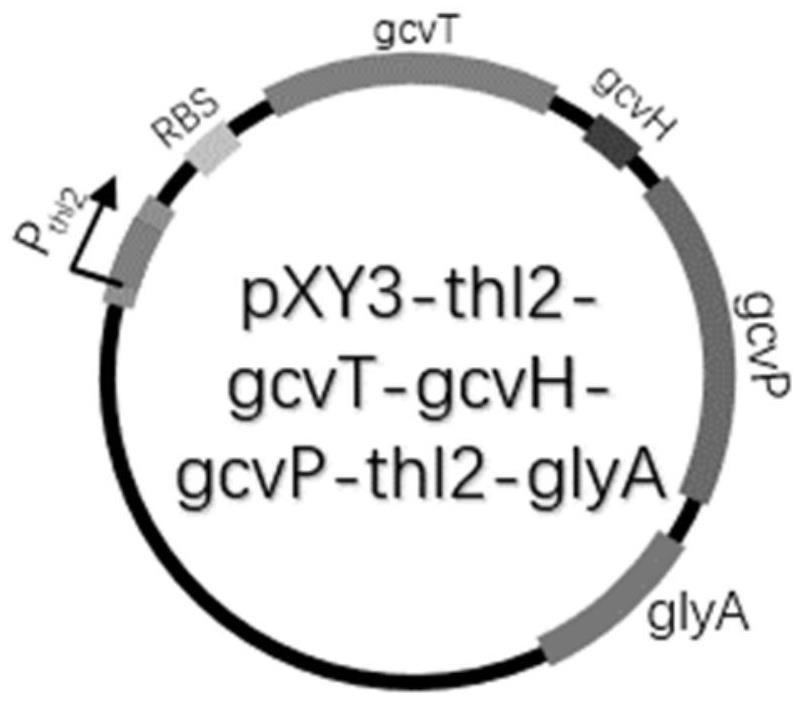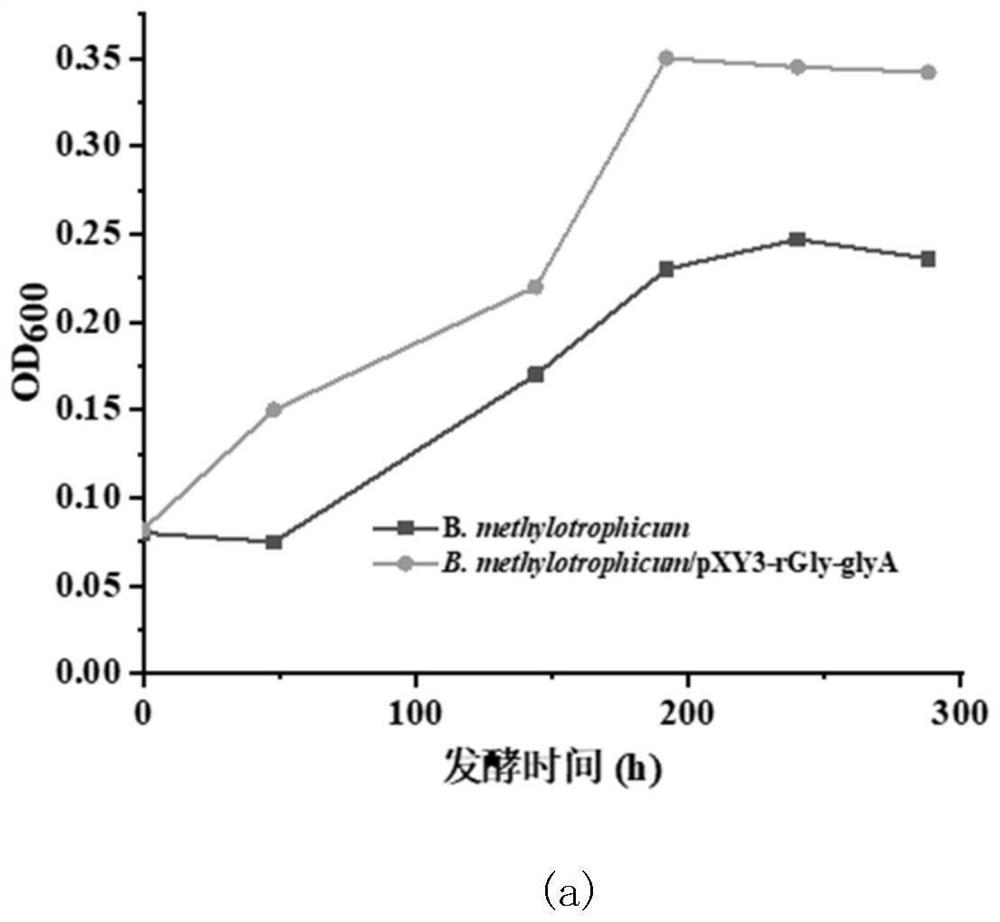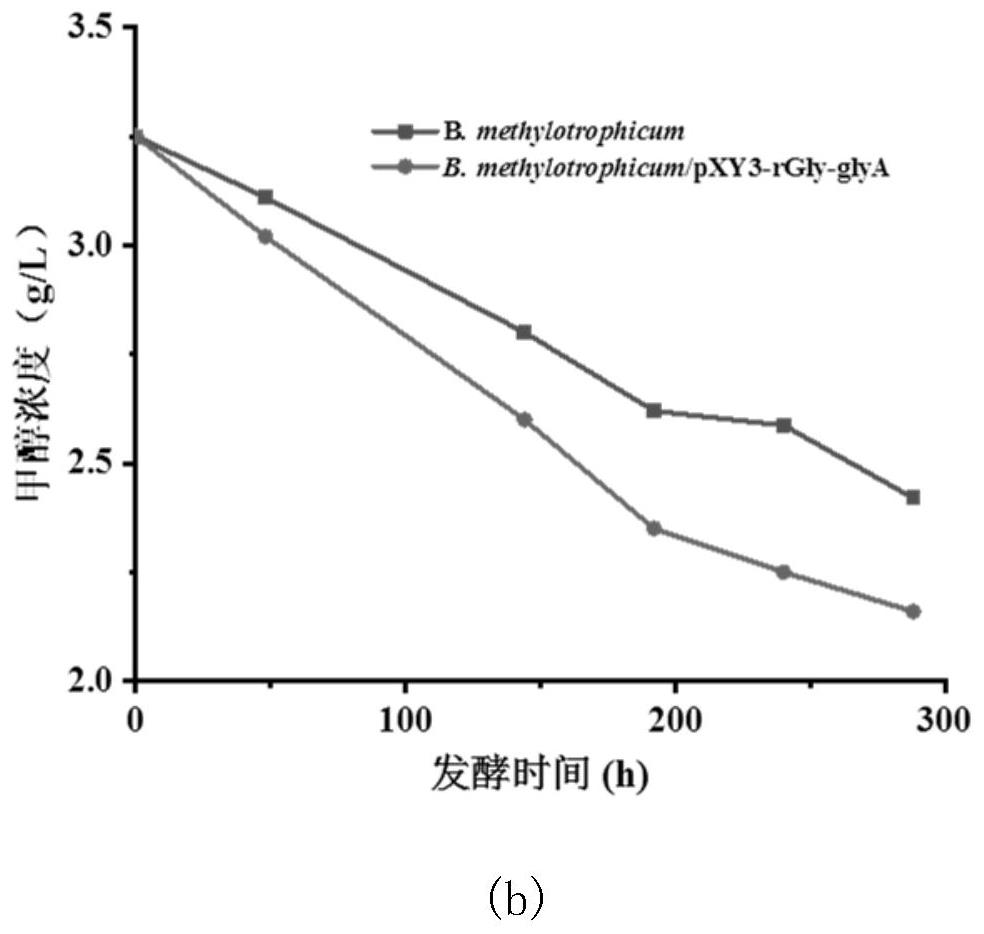Reconstructed butyric acid bacillus methylophilus for synergistically assimilating methanol by utilizing WLP (White Like Prescription) pathway and reducing glycine pathway and application of reconstructed butyric acid bacillus methylophilus
A technology of butyricum methylophilus and serine hydroxymethyl, applied in the field of genetic engineering, can solve the problems of restricting the development and application of strains, not involving genetic engineering transformation, etc., to achieve the improvement of methanol assimilation efficiency and the highest biomass, and increase the methanol Effects of assimilation and butyrate synthesis efficiency
- Summary
- Abstract
- Description
- Claims
- Application Information
AI Technical Summary
Problems solved by technology
Method used
Image
Examples
Embodiment 1
[0029] Example 1 Construction of pXY3-rRGS-thl2-glyA plasmid
[0030] 1. Construction of pXY3-thl2-rRGS plasmid
[0031] Using the existing laboratory plasmid pTrc99a-rGCS (for its construction method, see the publication number CN112920984 A) as a template, the aminomethyltransferase ( GcT ), glycine cleavage system H protein ( GcH ), glycine decarboxylase ( GvP ) coding sequence.
[0032] upstream primer with Bam H I enzyme cutting site, sequence is as shown in SEQ ID No.1:
[0033] CGCGGATCCATGGCACAACAGACTCCTTTG;
[0034] downstream primers with Xba I enzyme cutting site, sequence is as shown in SEQ ID No.2:
[0035] CGCGGATCCTTACTGGTATTCGCTAATCGGTACGC.
[0036] The reaction conditions are: 95°C for 2min, 95°C for 20s, 55°C for 20s, 72°C for 180s, a total of 30 cycles; 72°C for 5min; the obtained sequence was subjected to 1% agarose gel electrophoresis to recover the corresponding fragment; the sequence was compared with the expression The vector pXY3 uses the...
Embodiment 2
[0055] Example 2 Construction and fermentation phenotype of BM / pXY3-rRGS-thl2-glyA strain
[0056] The plasmid pMCljs was heat-shock transformed into Escherichia coli Top10 to obtain the recombinant strain Top10 / pMCljs, and the recombinant strain was prepared into competent cells. For the specific operation method, see the patent publication number: CN 113106047 A.
[0057] The recombinant plasmid pXY3-rRGS-thl2-glyA was transformed into competent Top10 / pMCljs to obtain the recombinant strain Top10 / pMCljs / pXY3-rRGS-thl2-glyA. Inoculate the recombinant strain in 5ml of LB medium containing ampicillin resistance at a final concentration of 50ug / mL and 100ug / mL phatomycin hydrochloride, culture at 37°C for 12 hours and extract the plasmid to obtain the methylated plasmid pXY3-rRGS -thl2-glyA. Finally, the methylated plasmid pXY3-rRGS-thl2-glyA was transformed into Bacillus methylbutyophilus to obtain a reconstituted strain: BM / pXY3-rRGS-thl2-glyA.
[0058] Pick a single colony o...
Embodiment 3
[0059] Example 3 Optimization of fermentation conditions for BM / pXY3-rRGS-thl2-glyA strain
[0060] Pick a single colony of BM / pXY3-rRGS-thl2-glyA on the plate, inoculate it into 2ml YTF medium containing erythromycin with a final concentration of 30ug / mL, and culture it for 12-16h. Transfer all to ampoule and grow to OD 600 For 1-1.2, pour the bacterial solution into a 50ml centrifuge tube, centrifuge at 4000rpm for 10min, discard the supernatant, resuspend with PB medium, and measure OD 600 =0.1 inoculum amount was inoculated into 50ml PB medium, and then 100mM-500mM methanol was added (such as image 3 As shown, the growth of 100mM methanol is the best, while 400mM methanol consumes the most methanol, 200mM methanol has the best butyric acid synthesis ratio, but the difference is weak, so 100mM methanol concentration is the best concentration), 0-60mM carbonic acid sodium hydrogen (as Figure 4 As shown, the growth, methanol consumption and butyric acid synthesis of the ...
PUM
 Login to View More
Login to View More Abstract
Description
Claims
Application Information
 Login to View More
Login to View More - Generate Ideas
- Intellectual Property
- Life Sciences
- Materials
- Tech Scout
- Unparalleled Data Quality
- Higher Quality Content
- 60% Fewer Hallucinations
Browse by: Latest US Patents, China's latest patents, Technical Efficacy Thesaurus, Application Domain, Technology Topic, Popular Technical Reports.
© 2025 PatSnap. All rights reserved.Legal|Privacy policy|Modern Slavery Act Transparency Statement|Sitemap|About US| Contact US: help@patsnap.com



